Brace yourselves – Slava is coming
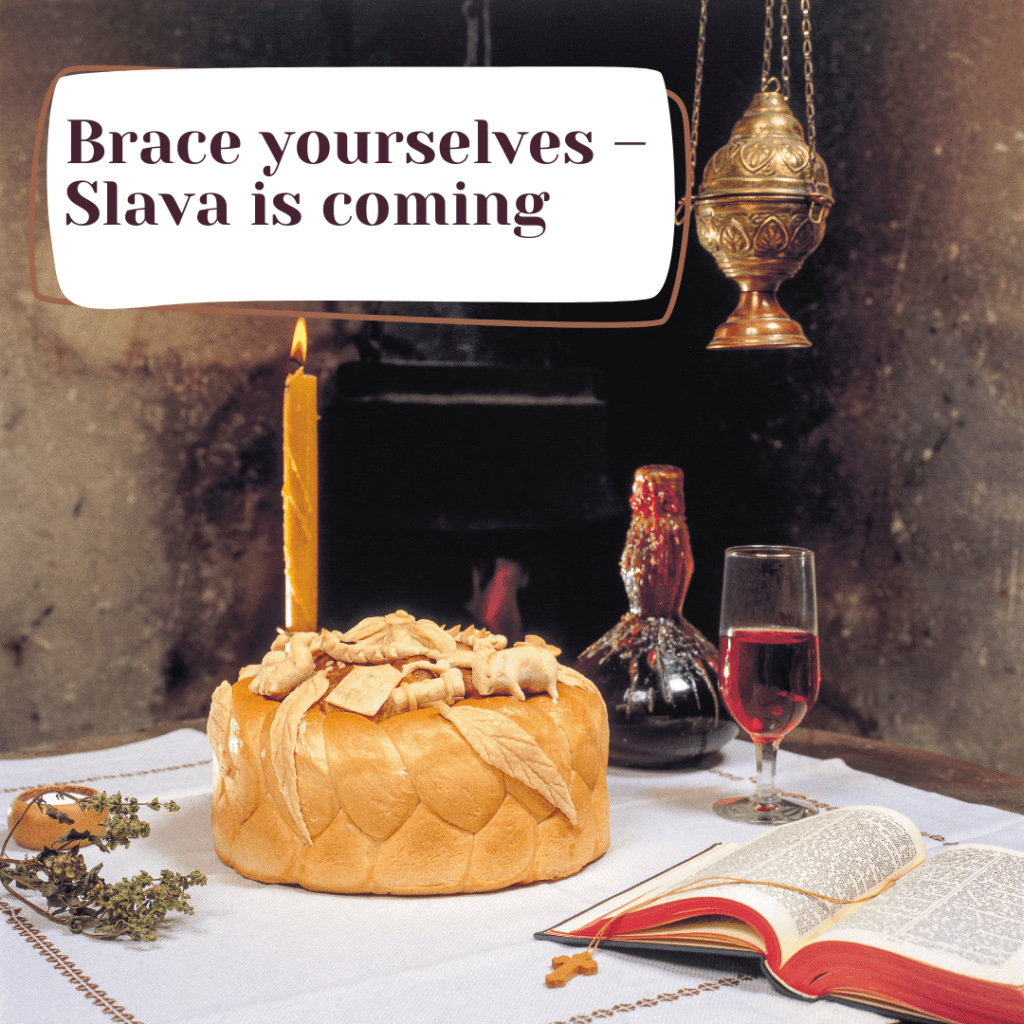
Slava season lasts throughout the year. Yet, once it becomes crispy cool, the evening breeze brushes through the fallen leaves outside your home, you prepare flour and meat, warm your oven, and you know – it’s slava season.
Slava is the traditional ritual of glorification of a family’s patron saint. It is celebrated annually on the saint’s feast days – days when Serbian people take the word “feast” oh too literally. Slavas are glorious holidays where we eat, drink, take a day off from work, and another day to recover.
As a tradition with important ethnic markers of Serbian identity, slava is passed down from father to son. Only men are allowed to carry out the slava rituals, even though the woman of the house – the spine of the family that supports the head – plays an important role. Upon marriage, women usually adopt the patron saints of their spouses, yet it is not uncommon for them to continue celebrating their native family’s saint, too.
One way or another, something’s got to give, and a saint or two shall be venerated.
Nearly all of these big holidays are celebrated in fall and winter. There are many slava feast days that fall in spring or summer, however, slava’s just not the same when it’s 100 degrees outside. No one wants to spend days in the kitchen, by the stove, cooking, baking, sauteing, grilling, and then washing endless piles of dishes when it’s warm outside.
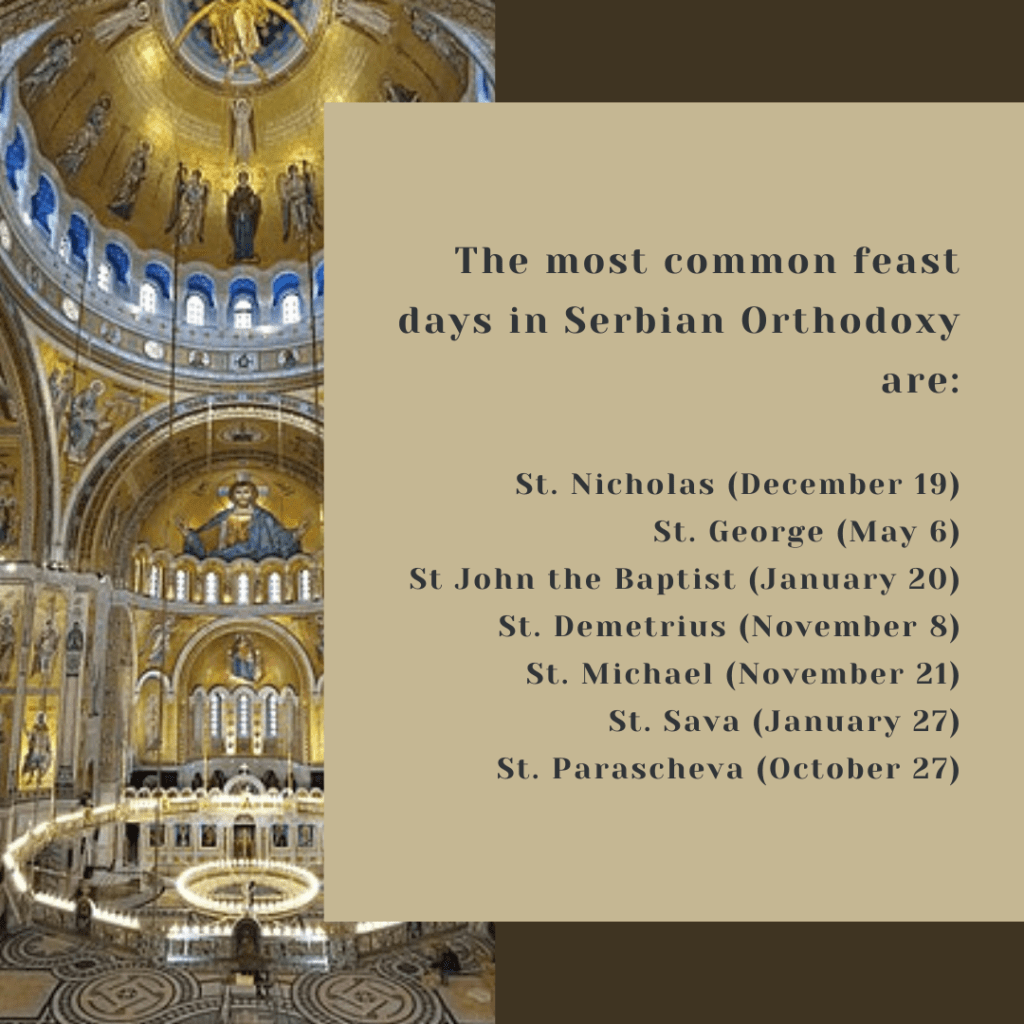
On the day of the slava, the parish priest comes to the house. He sings a little, spray holy water on the walls, blesses each member of the household, and performs the sacred ritual of consecrating slavski kolač (bread) and žito (boiled wheat dish) with red wine. These three components are essential for every slava – the body of Christ, the blood of Christ, and the symbol of Christ’s resurrection.
A beeswax candle is lit on the table, stamped with an image of the patron saint (optional). You do not extinguish the candle until nightfall, or in some cases until the last guest has left. Considering the duration of a typical slava, the candle would have to be well over six feet tall.
The priest pours a few tablespoons of wine on the bread. He turns it upside down and cuts it into quarters. The family gathers around the priest and with joint efforts, they break the bread into smaller pieces, ideally quarters – but it doesn’t really matter since the body of Christ will later be consumed entirely.
The family then kisses the cross here and there, makes the sign of the cross, says amen a few times, and the ceremony is over. Now it’s time to eat.
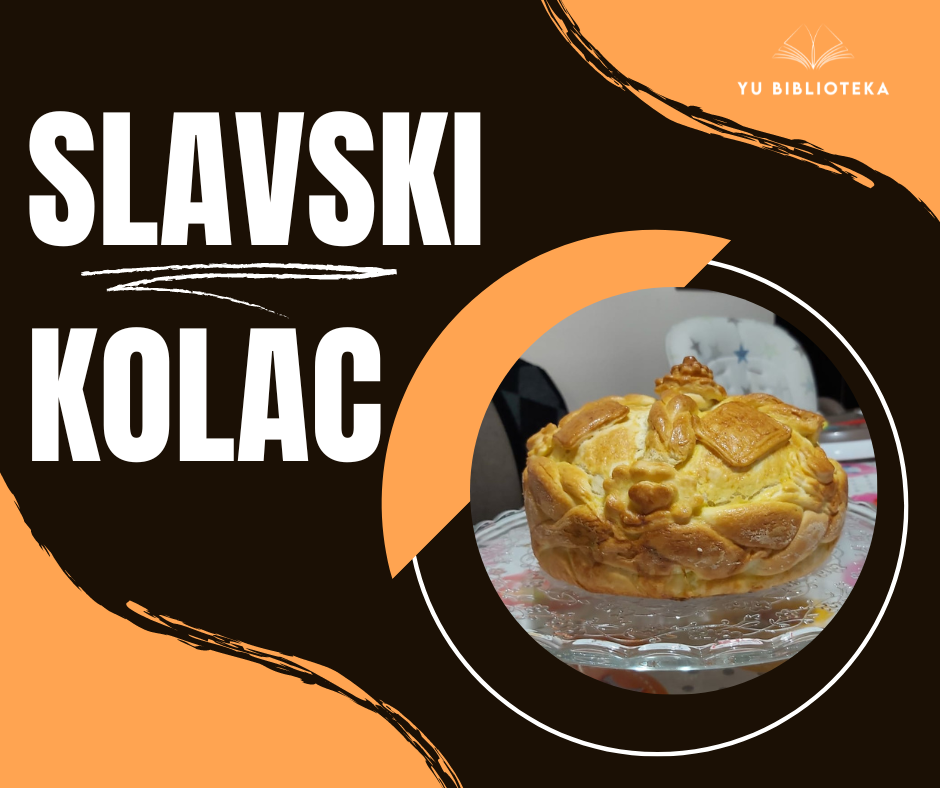
No slava can take place without the traditional Serbian cake-bread. The word kolač in Serbian translates literally to cake (biscuit, not the birthday type), but what it really is a bread.
It is round, baked in a pot, can taste sweet if you indulge the dough with enough sugar, and is always, absolutely always, the star of every slava. During lent, slavski kolač is made vegan, but is equally scrumptious.
Here’s how to make one exceptional slava cake-bread. You will need:
- 1kg (2.2lbs) flour
- 500ml (2 cups) tepid water
- 120ml (½ cup) oil
- 1 tsp salt
- 1 tsp sugar
- 20g (¼ cup) fresh yeast (dry yeast will do)
- ½ tsp baking powder
Mix yeast with sugar and some water, and leave it to rest for a few minutes. In a separate bowl, mix flour with baking powder. Once the starter has risen, whisk in the flour in batches – we don’t want any lumps. (At this point, I normally switch to a spatula.) Add salt. Once the dough becomes firmer, use your hands. Knead it until the dough is smooth and airy. The airier the better! Cover it and let rest for an hour in a warm, cozy place.
Once it’s big and fluffy, divide your dough into one larger part and two smaller ones. You need the smaller bits to make the decoration. Place the larger dough in a greased and floured pot. Just in case, line the bottom with parchment paper. As you work on the decoration pieces, the dough will rise some more in the pot.
Braid one piece of leftover dough. For a better esthetical effect, make sure the braids are thicker and long enough to cover the rim of the bread. You wrap it around the dough using water as glue. From the last piece of dough make two smaller braids – place them on top, creating an x (a cross) – and other decorations like flowers, grapes, wheat, doves, and four stamps with letters of abbreviation for Jesus Christ.
Before baking – 50-60 minutes at 390F or less; adjust the temperature accordingly – glaze your bread with a mixture of eggs and oil.
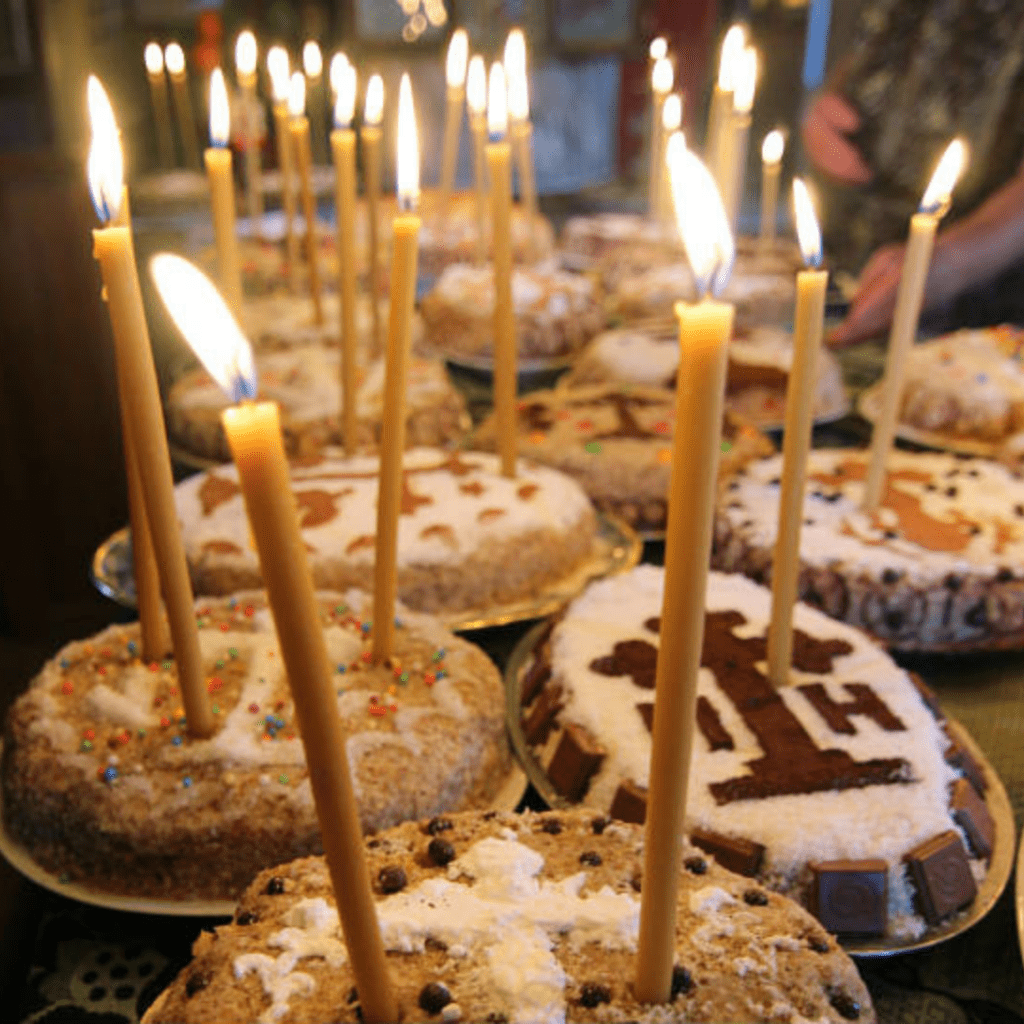
Žito or Panajia
Another staple in the traditional saint celebration, žito is a dish of boiled wheat mixed with ground walnuts and sugar. The presence of sugar does not label it a dessert – although it is eaten as one during the post-slava leftover days.
Žito (or koljivo) is a symbol of Christ’s resurrection. During the consecration ritual before the feast, the priest spills a teaspoon or so of wine on it – for important consecration purposes, I guess – and a thin beeswax candle is lit in the center. Žito is served before the meal starts, to every guest that arrives, usually by the youngest members of the family, on a tray with two glasses of water, one that holds teaspoons and the other filled with water. The guest makes the sign of the cross and takes a spoonful of žito, placing the dirty spoon into the water glass.
You are NOT supposed to drink from the glass with dirty teaspoons. Don’t ask how I know.
Here’s how to make it:
- 300g (10oz) wheat
- 300g (10oz) ground walnuts
- 250g (1 cup) granulated sugar
- Nutmeg and cinnamon to taste
Wash the wheat with water. In a deeper pot, place wheat with clean water and let it boil. Drain the wheat, pour clean water, and repeat. Make sure the grain is thoroughly boiled and soft. (Some of the grains might open up during boiling. That’s fine.)
After the last boil, let it simmer for half an hour, and remove it from the stove. Leave it in to cool down and swell some more, the longer the better (at least 3-4 hours). Before draining the wheat, reserve about 1 cup of the liquid.
Process the cooked wheat in a blender or a food processor, adding a bit of reserved water if needed to keep the blender going. When it’s nice and smooth, mix it with ground walnuts and sugar, and add a touch of nutmeg and cinnamon to taste. Adjust the taste – make it sweeter if needed; vanilla infused sugar is always a good idea.
When žito is done, place it either in a smaller bowl and smooth out the top, or shape it into a mound on a plate. Dust it with more ground walnuts or powdered sugar, and decorate with crushed walnuts, raisins, or even cocoa powder.
The best way to enjoy žito is to wait for all the guests to leave, and as you clean the table and wash the dishes at 1 am, take heaping spoons of the leftover walnut-sweet-wheat to free up space in the fridge.
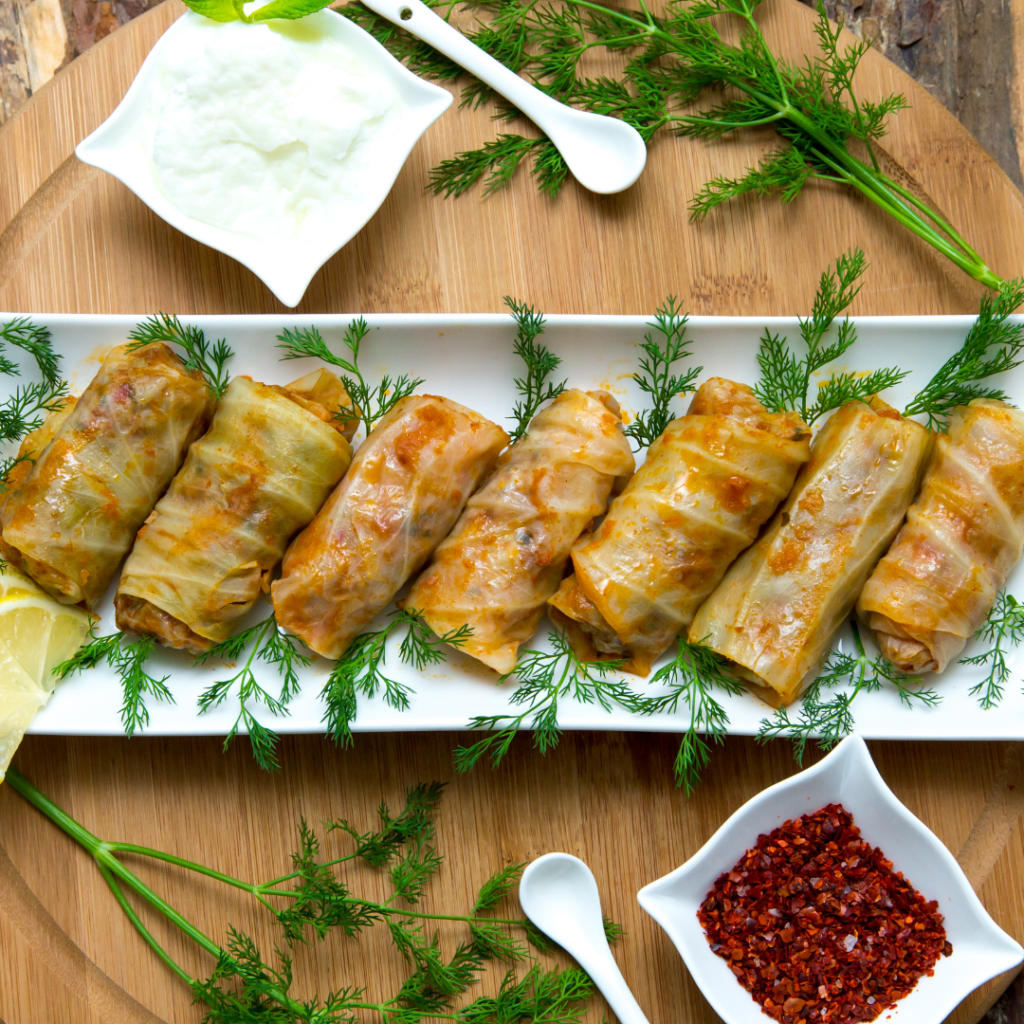
Her Majesty – Sarma
And now, the queen of every special occasion, the mistress of the most mundane family meals, the one and only – Her Majesty Sarma.
Sarma is the most scrumptious, most delicious, most gratifying thing that’s ever come out of Serbian cuisine – although, technically, it’s not authentically Serbian. The notion of stuffed cabbage leaves originated somewhere in the Middle East, and it was transported to the Balkan peninsula via Ottoman influences (no, not the furniture).
The fermented cabbage leaves – but also collard, grapevine, kale, and chard – are rolled around a filling of minced meat, grains (usually rice), or both. For the most classic, beloved sarma recipe, we use sauerkraut (pickled cabbage). No side dishes are required here, only bread to soak up the beautiful sarma juices.
You’ll need:
- 1 head sauerkraut (medium-sized), drained
- 1.5 pound minced pork
- 1 cup raw rice, rinsed
- 2 large onions
- garlic cloves, as many as your heart desires
- 6 medium smoked ribs or other smoked meat
- 2 tbsp sweet smoked paprika
- Salt, pepper to taste
Start by sauteing finely chopped onions over medium heat. Salt to taste, add sweet paprika, and then pork. Before you are ready to take the meat off the stove, add raw rice and mix well and make sure you seasoned well.
Prepare your humongous pot. Lay some sauerkraut leaves on the bottom, toss in a few raw garlic cloves, and start rolling your sarma. Take a cabbage leaf and place it on your palm. Fill the center with a tablespoon of the mixture, and roll it by carefully folding each side of the leaf. Don’t make it too tight – rice in the filling will gain volume during cooking, so it needs space to breathe. Arrange your cabbage rolls in rows. Toss in some of the smoked meat here and there along with more garlic cloves.
On the top of the last row, place a few more cabbage leaves. Pour with water to cover the cabbage rolls and place a plate upside down to press on them. Cook on medium heat. Let it simmer for three to four hours.
The last step – make a roux that will take your sarma to the next level! Simply heat some oil (butter can do, but lard is probably the best), add a tablespoon of flour, and whisk constantly. When the flour turns slightly brown, remove from heat and add a tablespoon of sweet paprika. Whisk some more – no lumps – and pour over your glorious sarma pot. Put your sarma in the oven – at 350F for another 20-30 minutes – to give it that wonderful, bakey taste.
There you have it. Three top-notch recipes for the three most Serbian things you can serve your guests at a slava. You’re welcome.
Truly yours,
Vanja
